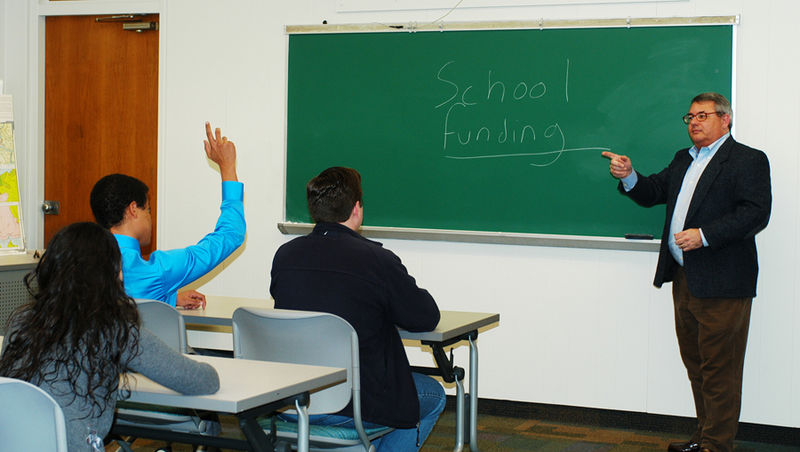By: Alex Edquist

Georgia education funding might have its problems (as GPR’s Darrian Stacy described last week), but at least our state can say a court has never ruled its spending levels unconstitutionally low. Kansas, on the other hand, can. Kansas, like all 50 states, has a clause in its state constitution guaranteeing a free, quality public education for all. However, the Kansas state legislature has cut school spending severely since 2009, and now its education spending is 16.5 percent below the 2008 level, which a Kansas district court ruled as too low to provide a suitable education for Kansan students. To make up for this deficit, the court ordered the Kansan legislature to add $440 million in funding to education.
This is not the first time Kansas has faced this issue. In suits in 1972, 1990, and 2001-2006, its courts ruled that its legislatures had to increase education funding. Nor is Kansas the only state to face these issues: nine other states, ranging from Connecticut to Florida to Washington, are also dealing with litigation concerning their education funding.
Like many states, Kansas has struggled with its state budget since the recession. Kansas’s tax revenue has been hampered not only by the economic crisis, but also by the $800 million tax cut passed by the legislature in 2012, which reduced Kansas’s revenue by 12.8 percent. The tax cut reduces the income tax rate of the highest-earning Kansans and eliminates non-wage income taxes on small businesses.
Kansas is appealing the case, and the Kansas Supreme Court is expected to make a decision by the end of January. In his State of the State address, Republican Governor Sam Brownback said the court should not rule for more funding because, “The Constitution empowers the Legislature—the peoples’ representatives—to fund our schools.” If the Kansas Supreme Court agrees with the earlier court’s ruling that current education funding levels are unconstitutionally low, the Kansas legislature has threatened to undermine the decision by either amending the state constitution, refusing to add funding, or reallocating the necessary spending from higher education (although funding for higher education in Kansas has already been cut by 8 percent).
The legislature might be forced to take these measures because they lack the revenue to restore funding to the levels ordered by the district court. The income tax cuts have left Kansas cash-strapped, and many of its more conservative legislators are pushing for further reductions in taxes. Kansas expects to have a $295 million budget shortfall for fiscal year 2014 even after using its $470 million surplus fund. Gov. Brownback has addressed the budget issues by increasing the sales tax and removing tax credits for items like childcare, but the Kansan Tea Party has opposed further revenue-increasing measures.
Given these budget problems, Kansas increasing its education funding doesn’t seem likely or feasible. However, the governor is also asking for $80 million to fund universal all-day kindergarten. “Contrary to popular belief, it is possible to increase spending on education and cut taxes at the same time,” Gov. Brownback said. Meanwhile, in response to funding decreases, Kansas’s school districts are closing schools, cutting jobs, and removing programs.
Low taxes and well-funded education are often cited as paths to future economic well-being. Kansas and other similar states hope to create jobs by cultivating small businesses and luring bigger corporations to relocate to within their borders. Kansas’s Department of Revenue is predicting that the tax cuts will create 23,000 more jobs by 2020 than would have otherwise existed. But investment in education also equips students to perform better economically in the future.
Ultimately, these two strategies cater to two very different economies. Pro-business policies can help a state land new plants and factories that bring lots of manufacturing jobs. But while American manufacturing is on the upswing, it’s uncertain if manufacturing will remain a steady source of middle-income jobs for long. Many manufacturing jobs have already been replaced by automation, a trend that shows no sign of reversing any time soon. Meanwhile, the demand for high-skill labor is rising fast. Although budgets are tight, states would be wise to provide enough funding for education to prepare their students for the high-skill, well-paid, and in-demand jobs that will not be easily replaced by robots, ranging from computer analysts to nurses to electricians.
Despite the lawsuit, Kansas’s schools are doing pretty well (Gov. Brownback replied to the New York Times opinion piece damning Kansas for slashing school funding by pointing out areas where Kansas students were outperforming New York ones). However, an America full of ‘doing pretty well schools’ doesn’t stack up against other developed countries. To ensure future competitiveness, states should willingly provide the funds necessary for the high levels of education and training needed for tomorrow’s economy, rather than lawsuits and court orders having to extract them forcibly.

